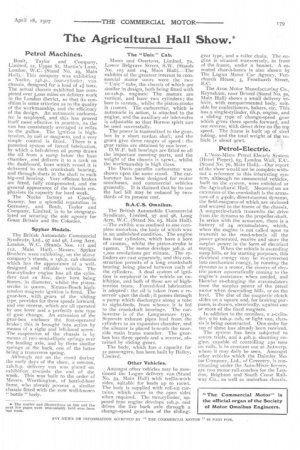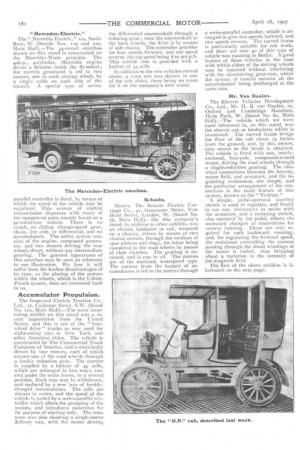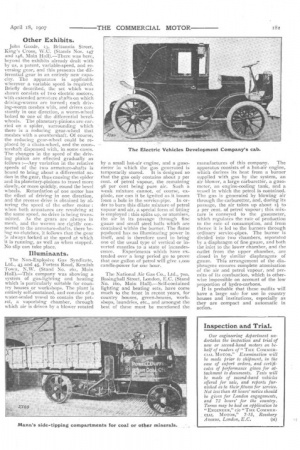The Agricultural Hall Show.*
Page 51

Page 52

Page 53

If you've noticed an error in this article please click here to report it so we can fix it.
Petrol Machines.
Boult, Taylor and Company, Limited, 12, Upper St. Martin's Lane, London, W.C. (Stand No. 29, Main Hall).--This company was exhibiting Nacke, 4h.p., four-cylinder; van chassis designed for a load of 21 tons. The actual chassis exhibited has completed over 5,000 miles on delivery work in the London district, so that its condition is some criterion as to the quality of the workmanship, and the efficiency of the design. An automatic carburetter is employed, and this has proved itself most effective in practice, as the van has consistently averaged 12 miles to the gallon. The ignition is hightension, by coil or magneto, and a very simple control is fitted. There is a patented system of forced lubrication, by which a belt-driven oil pump draws the oil from a sump below the base chamber, and delivers it to a tank on the dashboard, from which vessel it is delivered to each crankshaft bearing, and through ducts in the shaft to each big-end bearing. Very efficient brakes are fitted, fully compensated, and the general appearance of the chassis emphasises its capacity for hard work.
The Nacke factory at Coswig, Saxony, has a splendid reputation in Germany, and Boult, Taylor and Company, Limited, is to be congratulated on securing the sole agency for Great Britain and the Colonies.
Spyker Models.
The British Automobile Commercial Syndicate, Ltd., 97 and 98, Long Acre, London, W.C. (Stands Nos. Hz and 112, Main Hall).—Messrs. Spyleer Brothers were exhibiting, on the above company's stands, a I5h.p. cab chassis which has the appearance of a welldesigned and reliable vehicle. The four-cylinder engine has all the cylinders cast en bloc, their bore being 8omm. in diameter, whilst the pistonstroke is 90MM. Simms-Bosch hightension magneto ignition is fitted. The gear-box, with gears of the sliding type, provides for three speeds forward, and one reverse, which are all operated by one lever and a perfectly new type of gate change. An extension of the gear-box encloses the foot-operated brake ; this is brought into action by means of a right and left-hand screw. The suspension of the chassis is by means of two semi-elliptic springs over the leading axle, and by three similar springs at the back, one of the latter being a transverse spring.
Although not on the stand during the early days of the show, a one-ton, 22b.h.p. delivery van was placed on exhibition towards the end of the week. This was built to the order of Messrs. Worthington, of bottled-beer fame, who already possess a similar chassis fitted with the now well-known " bottle " body.
The " Unic" Cab.
Mann and Overtons, Limited, 7a, Lower Belgrave Street, S.W. (Stands No. 103 and 104, Main Hall).—The exhibits of the greatest interest to commercial motor users were the two " Unic " cabs, the chassis of which are similar in design, both being fitted with zo-1211.p. engines: The motors are vertical, and have two cylinders ; the bore is 102mm. whilst the piston-stroke is Hamm. The carburetter, which is automatic in action, is attached to the engine, and the auxiliary air inlet-valve is adjustable so that Borneo spirit can be used successfully.
The power is transmitted to the gearbox by a short cardan shaft, and the gears give three ranges of speed : the gear ratios are obtained by one lever.
D.W.F. ball bearings are fitted to all the important running parts, and the weight of the chassis is mcwt., whilst the workmanship is high class.
The Davis paraffin carburetter was shown upon the same stand. The carburetter has been designed for motor omnibuses, and commercial vehicles generally. It is claimed that by its use the fuel bill may be reduced by twothirds of its present cost.
B.A.C.S. Omnibus.
The British Automobile Commercial Syndicate, Limited, 97 and 98, Long Acre, W.C. (Stand No. 65, Main Hall). —The exhibit was confined to one complete motorbus, the body of which was in an unfinished condition. The engine has four cylinders, which have a bore of I20MM., whilst the piston-stroke is momm. The motor develops 3oh.p. at ',ono revolutions per minute. The cylinders are cast separately, and this construction permits of a long crankshaft bearing being placed between each of the cylinders. A dual system of ignition is employed in the vehicle on exhibition, and both of these are of hightension types. Forced-feed lubrication is adopted : the oil is taken from a reservoir upon the dash ; it passes through a pump which discharges along a tube to sight-feeds, from whence it is led to the crankshaft bearings. The carburetter is of the Longuernare type. Separate exhaust pipes lead from the cylinders to an expansion chamber, and the silencer is placed beneath the nearside main frame member. The gearbox has three speeds and a reverse, obtained by sliding gears.
The body, which has a capacity for 32 passengers, has been built by Bailey, Limited.
Other Vehicles.
Amongst other vehicles may be mentioned the Logan delivery van (Stand No. 59, Main Hall) with trellis-work sides, suitable for loads up to zocwt. The body is supplied with roll-up curtains, which cover in the open sides when required. The two-cylinder, opposed type engine develops toh.p. and drives the live back axle through a change-speed gear-box of the sliding
gear type, and a roller chain. The engine is situated transversely, in front of the frame, under a bonnet. A 20seated char-a-bancs is also shown by The Logan Motor Car Agency, Fenchurch House, 5, Fenchurch Street, E.C.
The Avon Motor Manufacturing Co., Keynsham, near Bristol (Stand No. 50, Main Hall) shows a small delivery vehicle, with compartmented body, suitable for confectioners, bakers, etc. This has a single-cylinder, 6h.p, engine, and a sliding type of change-speed gear which gives three speeds forward, and one reverse, with direct drive on the top speed. The frame is built up of steel tubing, and the total weight of the vehicle is about 9cwt.
Petrol-Electric.
L'Auto-Mixte Petrol Electric System (Henri Pieper), 65, London Wall, E.C. (Stand No. 76, Main Hall).—Our report of the show would not be complete without a reference to this interesting system, although no commercial vehicles, built on the system, were exhibited at the Agricultural Hall. Mounted on an extension of the crankshaft is the armature of a 4-pole, direct-current dynamo, the field-magnets of which are enclosed and secured to the frame of the chassis. A magnetic-clutch transmits the drive from the dynamoto the propeller-shaft. In series with the armature, there is a battery of 24 accumulators, which, when the engine is not called upon to transmit to the road-wheels all the power generated, receive and store the surplus power in the form of electrical energy. When the vehicle is ascending steep hills, or for starting purposes, this electrical energy may be re-converted into mechanical energy, by running the dynamo as a motor, the reserve of electric power automatically coming to the engine's assistance when needed, and likewise re-charging the accumulators from the surplus power of the petrol motor when descending hills, or on the level. The disc of the magnetic clutch slides on a square and, for braking purposes, is drawn, electrically, against one or more of the fixed magnets.
In addition to the omnibus, a 2-cyl1n, der, 9 to zoh.p. cab, or light van, chassis is being constructed. One order for zoo of these has already been received.
The system has been subjected to severe trials, and a 4oh.p. shunting engine, capable of controlling 250 tons on rails, is in constant use at Antwerp, where it may daily be seen. Amongst other vehicles which the Daimler Motor Company, Ltd., of Coventry, is constructing under the Auto-Mixte licence, are two motor rail-coaches for the London, Brighton and South Coast Railway Co., as well as motorbus chassis.
The " Mercedes Electric," I2A, Savile Row, W. (Stands Nos. iig and 120, Main Hall).—The 34-seated omnibus shown on this stand is constructed on the Mercedes-Mixte principle. The 4oh.p., 4-cylinder, Mercedes engine drives a dynamo inside the fly-wheel ; the current generated is led to two motors, one in each ariyingwheel, by a single cable on each side of the chassis. A special type of series
parallel controller is fitted, by means of which the speed of the vehicle may be regulated. This system of electric transmission dispenses with many of the component parts usually found on a petrol-driven vehicle. There is no clutch, no sliding change-speed gear, chain, live axle, or differential, and no accumulators. The entire system consists of the engine, compound generator, and two motors driving the rear wheels direct, without any intermediate gearing. The general appearance of this omnibus may be seen on reference to our illustration. We fear it will suffer from the known disadvantages of its type, as the placing of the motors within the wheels, which is the ',ohneForsch system, does not commend itself to us.
Accumulator Propulsion.
The Improved Electric Traction Co., Ltd., 17, Cockspur Street, S.W. (Stand No. tzo, Main Hall).—The most interesting exhibit on this stand was a recent importation from the United .States, and this is one of the " fourwheel drive " trucks as now used for sight-seeing cars in New York and other American cities. The vehicle is constructed by The Commercial Truck Company of America, and is electrically driven by four motors, each of which rotates one of the road wheels through a double reduction gear. The current is supplied by a battery of 44 cells, which are arranged in two trays, carried under the main frame, in a central position. Each tray may be withdrawn, and replaced by a new tray of freshlycharged accumulators. The cells are always in series, and the speed of the vehicle is varied by a series-parallel controller which alters the grouping of the motors, and introduces resistance for the purpose of starting only. The company was also showing. a single-motor delivery van, with the motor driving the differential countershaft through a reducing-gear ; from the countershaft to the back wheels, the drive is by means of side chains. The controller Provides for four speeds forward, and one speed reverse, the top speed being 8 to gm.p.h. This vehicle also is provided with a battery of 44 cells.
inaddition to the two vehicles named above, a 1-ton van was shown, in one of the side aisles, there being no room for it on the company's own stand.
Scheele., Messrs. The Scheele Electric Carriage Co., 41, Grosvenor Mews, New Bond Street, London, W. (Stand No. .78, Main Hall).—On this company's stand, in addition to other exhibits, was an electric landaulet or cab, mounted on a chassis, driven by means of two electric motors, through the medium of spur pinions and rings, the latter being connected to the road wheels by means of claw clutches. The gearing is enclosed, and is run in oil. The motors are of the enclosed, waterproof type. The current from the battery of accumulators is led to the motors through a series-parallel controller, which is arranged to give five speeds forward, and two speeds reverse. The curved frame is particularly suitable for cab work, and there are over 40 of this type of vehicle now running in Berlin. A good feature of these vehicles is the ease with which either of the driving wheels may be removed without interfering with the oil-retaining gear case, whilst the system of control ensures all the accumulators' being discharged at the same rate.
Mr. Van Daalen.
The Electric Vehicles Development Co. Ltd., Mr. H. B. van Daalen, za, Oxford and Cambridge Mansions, Hyde Park, W. (Stand No. 8z, Main Hall).—The vehicle which we were most interested in, on this stand, was the electric cab or landaulette which is illustrated. The curved frame brings the floor of the cab about is inches from the ground, and, by this means, easy access to the inside is obtained. The vehicle is fitted wilh one, totallyenclosed, four-pole, compound-wound motor, driving the road wheels through a single-reduction gearing. The electrical connections between the battery, motor field, and armature, and the regulating resistances, are simple, and the particular arrangement of the connections is the main feature of this system, known as the " Vedrine."
A simple, pedal-operated starting switch is used to regulate, and finally to cut out, resistances in series with the armature, and a reversing switch, also operated by the pedal, effects the necessary changes of connections for reverse running. These are only required for such backward running, and, for regulating the forward speed, the resistance controlling the current passing through the shunt windings of the motor is varied, thus bringing about a variation in the intensity of the magnetic field.
The first of the above exhibits is illustrated on the next page.
Other Exhibits.
John Goode, 13, Britannia Street, King's Cross, W.C. (Stands Nos. 147 and 148, Main Hall).—There was here, beyond the exhibits already dealt with by us, a patent, variable-speed, and reversing gear, and this presents the differential gear in an entirely new capacity. The apparatus is applicable wherever a variable speed is required. Briefly described, the set which was shown consists of two electric motors., with extended armature shafts on which driving-worms' arc turned ; each driving-worm meshes with, and drives constantly in one direction, a worm-wheel bolted to one of the differential bevelwheels. The planetary-pinions are carried on a spider, surrounding which there is a reducing gear-wheel that meshes with a countershaft. Of course, the reducing gear-wheel could be replaced by a chain-wheel, and the countershaft dispensed with, in some cases. The changes in the speed of the driving pinion are effected gradually as follows :—Any variation in the relative speeds of the two armature-shafts is bound to bring about a differential action in the gear, thus causing the spider and its planetary-pinions to travel more slowly, or more quickly, round the bevel wheels. Retardation of one motor has the effect of driving in one direction, and the reverse drive is obtained by altering the speed of the other motor : when both armatures are revolving at the same speed, no drive is being transmitted. As the gears are always in mesh, and the worms are rigidly connected to the armature-shafts, there being no clutches, it follows that the gear is always locked at the speed at which it is running, as well as when stopped. No slip can take place.
Illuminants.
The Non-Explosive Gas Syndicate, Ltd., 43 and 45, Fortess Road, Kentish Town, N.W. (Stand No, 161, Main Hall).—This company was showing a system of gas-lighting, and heating which is particularlysuitable for country houses or workshops. The plant is entirely self-contained, and consists of a water-sealed vessel to contain the petrol, a vaporising chamber, through which air is driven by a blower rotated by a small hot-air engine, and a gasometer in which the gas generated is
temporarily stored. It. is designed so that the gas only contains about 2 per cent. of petrol vapour, the remaining 98 per cent being pure air. Such a weak mixture cannot, of course, explode, nor can it be ignited as it issues from a hole in the service-pipe. In order to burn this dilute mixture of petrol vapour and air, a special form of fitting is employed : this splits up, or atomises, the air in its passage through fine gauze and small steel balls which are contained within the burner. The flame produced has no illuminating power in itself, and is therefore used to bring one of the usual type of vertical or inverted mantles to a state of incandes cence. Experiments which have extended over a long period go to prove that one gallon of petrol will give i,000 candle-power for one hour.
The National Air Gas Co., Ltd., 7oa, Basinghall Street, London, F.C. (Stand No. 160, Main Hall).—Self-contained lighting and heating sets, have come much to the front in recent years, for country houses, green-houses, work-. shops, laundries, etc., and amongst the best of these must be mentioned the
manufactures of this company. The apparatus consists of a hat-air engine, which derives its heat from a burner supplied with gas by the system, an air blower, a large carburetter, a gasometer, an engine-cooling tank, and a vessel in which the petrol is contained. The gas is generated by blowing air through the carburetter, and, during its
passage, the air takes up about to per cent, of petrol vapour ; this mixture is conveyed to the gasometer, which regulates the rate of production to the rate of consumption, and from thence it is led to the burners through ordinary service-pipes. The burner is divided into two chambers, separated by a diaphragm of fine gauze, and both the inlet to the lower chamber, and the outlet from the upper chamber, are closed in by similar diaphragms of gauze. This arrangement of the diaphragms ensures complete atomisation of the air and petrol vapour, and permits of its combustion, which is otherwise impossible on account of the low proportion of hydro-carbons.
It is probable that these outfits will have a large sale for use in country houses and institutions, especially as they are compact and automatic in action.






























































